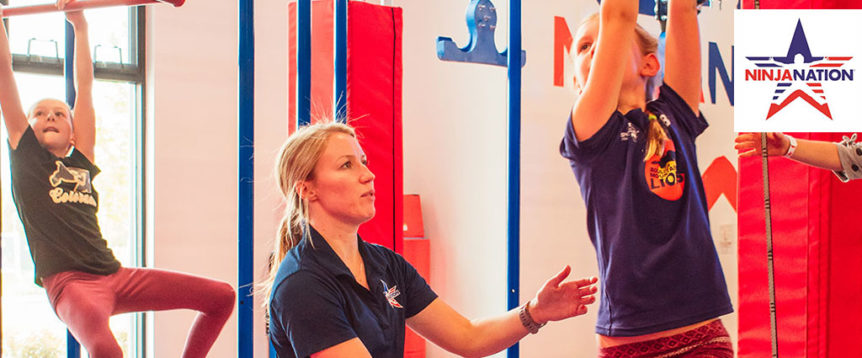For years, our family has marveled at the American Ninja Warrior obstacle-competition TV show, in which seemingly super-human competitors launch themselves from ring to ring, scamper up giant walls, summon massive upper-body strength to hop themselves up salmon ladders and more.
So when I learned that not only was there a Ninja-training gym near us, but that it was designed in a way that enabled anyone—from novices to world-class competitors—to participate, I was a teensy bit skeptical. One evening, our family of five (my husband, me and three teenage kids) visited Ninja Nation to put that claim to the test.
One of our hosts for the evening was Geoff Britten, essentially the LeBron James of Ninja Warriors. He’s the only person to ever have a perfect season on the TV show, conquering all six stages he faced. He’s also the fastest competitor to achieve total world Ninja victory—and that’s just the beginning of his Ninja résumé. We were in total awe.
On the other end of the spectrum was my 14-year-old son, David, who was born with a spinal tumor that has left him with limited function in his lower limbs. I was curious to see how this gym could accommodate David and Britten—and all of us in between.
Choose Your Challenge
What we found was a smartly designed, aesthetically pleasing and thoroughly welcoming gym that did exactly what it promised. Britten himself was the creative director behind the red, white and blue gym, which is divided into six zones with various obstacles. Each obstacle comes with a Ninja difficulty rating of N1 to N10, to let you know what you’re getting yourself into. And, to keep things interesting, the gym frequently swaps in different obstacles, offering fresh challenges.
All the zones except the advanced-training area contain obstacles accessible to any level. For example, the warped wall zone, in which you run up a curved wall to a platform at the top, has an 8-foot N1 version with a rope you can grab to help you pull yourself up, a 14.5-foot N5 version that Britten makes look easy but most mere mortals aren’t likely to achieve without a lot of practice, and two more-attainable walls in between.
Some of the zones—such as the high bay—look intimidating but serve as confidence boosters when you’re actually able to conquer the obstacles after a try or two or three. Or, even if you can’t, you realize you had a lot of fun in the process and that the worst thing that happened was that you dropped, laughing, into the massive cushion below you.
“One of the main mantras of the sport of Ninja, popularized by the TV show, is that everybody falls; everybody fails,” said Ninja Nation spokesperson Lucas Clarke, as we were hanging out in the high bay. “What matters is how you approach the next hurdle after that. So, when you fail, you say, ‘Oh, I learned something,’ and you get up and try again. That’s a microcosm of life.” As if on cue, as Clarke finished his sentence, my 13-year-old son, A.J., missed the rings he was launching for, plummeted into the cushy mat and got up to tackle the obstacle again. David was too nervous to try the rings, but he found his niche on a cargo-net climbing wall and some platform obstacles in the high-bay zone. My 15-year-old daughter, Shaelyn, was a natural on nearly every obstacle she tried.
Ninja for All
My kids are in the sweet spot for the gym’s biggest clientele: children ages 5 to 15, many of whom don’t enjoy traditional sports but want to keep moving, Clarke says. A subset of that group joins the Ninja Nation team, which trains for local, national and international Ninja competitions. Often, he adds, the kids’ families join in, when they see the efficiency of staying fit together—and having fun doing it. They can take classes together or separately, work with a trainer, or explore the obstacles open-gym style. Class options include both skills training and physical conditioning, perhaps in the form of warped-wall repeats, obstacle-course races, or box jumps or step-ups.
As we discovered by sampling all six zones—with admittedly zero success in the advanced-training zone—the beauty of the workout is its well-roundedness. It challenged all body parts (as some of us felt the next day), our strength and endurance, our mental fortitude, our courage and a few other areas that don’t always get taxed during conventional workouts.
“The sport of Ninja is known as life-proofing, because you’re working on things like balance and grip strength and agility,” Clarke says. “Those are skills you need in everyday life.” And skills, I like to think, that bring us just a bit closer to those super-humans we’ve long admired on TV.


